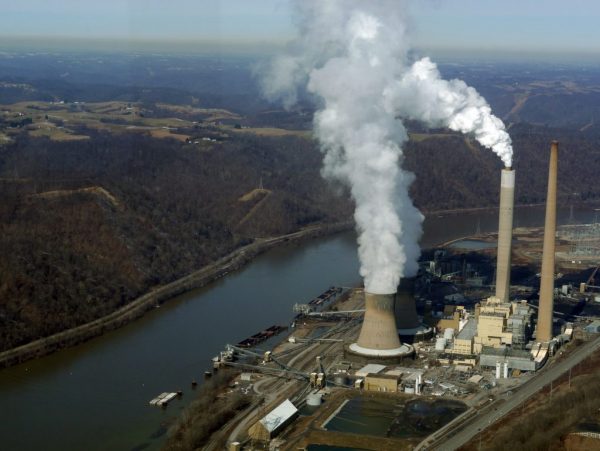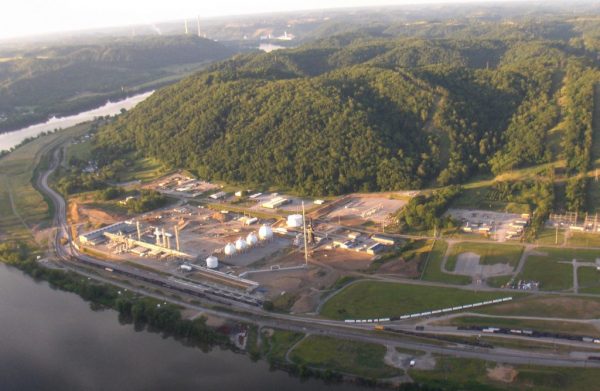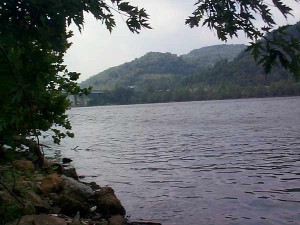- Like
- Digg
- Del
- Tumblr
- VKontakte
- Buffer
- Love This
- Odnoklassniki
- Meneame
- Blogger
- Amazon
- Yahoo Mail
- Gmail
- AOL
- Newsvine
- HackerNews
- Evernote
- MySpace
- Mail.ru
- Viadeo
- Line
- Comments
- Yummly
- SMS
- Viber
- Telegram
- Subscribe
- Skype
- Facebook Messenger
- Kakao
- LiveJournal
- Yammer
- Edgar
- Fintel
- Mix
- Instapaper
- Copy Link

One of many coal-fired power plants along the Ohio River. Photo by VS. Flyover: SouthWings.

A Dominion Gas facility along the Ohio River, with the smokestacks of a coal-fired power plant visible in the background. Photo by Bill Hughes.
Which would you choose? The Ohio River is already known as the most polluted inland waterway in the country, yet it is the tap water source for five million people. Given those facts, it seems a foolish choice to relax pollution control standards in any way. However, that is exactly what may happen if the Ohio River Valley Water Sanitation Commission [ORSANCO] implements a proposed change in the way it deals with pollution control standards.
This is a big, complex subject, but we can break it down this way: The Ohio River basin is a huge area: 981 miles of river, encompassing 12 states. Eight states have representatives on the ORSANCO Commission, serving alongside two federal appointees. There are also advisory committees; OVEC is involved (with one staff member and one volunteer representative) on the ORSANCO Watershed Organizations Advisory Committee (WOAC).
At a recent meeting of the ORSANCO Commission, those present, by a 14-6 margin, voted to choose an option of removing the Commission’s “triennial pollution control standards review” process. Essentially this means that the ORSANCO commission is proposing to abdicate its decades-old authority for setting pollution control standards (PCS) in the region. Here is the rationale that the Commission gave for this decision:
In recognition of the successes of the federal Clean Water Act and the related state water pollution control programs of member states, the Pollution Control Standards (PCS) should be revised by adding a provision that recognizes that water quality standards and criteria, as well as mixing zone requirements, and other provisions of the PCS are being adequately addressed by member states in accordance with programs appropriate for implementation of the federal Clean Water Act. To the extent that all member states are operating under such programs, the Commission may conclude that it need not continue the triennial review process related to the water quality criteria (and related provisions) of the PCS.
In a nutshell, the Commission is proposing to turn over all authority for setting and enforcing PCS to state environmental entities (like the WV DEP and the OH EPA). Read more about the ramifications of this recent decision here.
This could get very confusing, given the multiple states which border the Ohio River and tributaries. Pollution in one state that is deemed permissible by a state level agency, may not be permissible in states that are directly across the river from that state. Advisory and alert systems may be inconsistent or not able to communicate with each other. For example, when the MCHM pollutants were traveling downstream, ORSANCO was heavily involved in monitoring the “plume” of pollutants as it traveled into and down the Ohio River. Thus, public water intake systems in multiple states along the Ohio River were alerted and closed their intakes for a period of time as the pollutant plume passed.
Also, ORSANCO is responsible for working with states to issue fish consumption advisories and recreational advisories, based on pollution levels found in the Ohio River. Those of us who live, work and/or recreate in and around the Ohio River have come to depend on ORSANCO’s standards and monitoring processes, whether we fully realize it or not. Loosing their PCS oversight could be devastating to millions of people, and to 160 species of fish and other wildlife dependent upon the Ohio River ecosystem.
This is not a done deal! There will be more information to come (both from OVEC and ORSANCO), and a public comment period in mid-summer. The dates for this comment period and any public hearings are still being finalized, but there is a tentatively scheduled hearing in the Cincinnati area on July 26, if you want to mark your calendar. We will be organizing to get people to the hearing(s) once we see a finalized schedule. Comments may also be submitted in writing, and we will post the process for doing so, with talking points very soon.
This is a critical issue which calls on all people who value the Ohio River to show up and speak up! Fish, mussels, and birds cannot do so; we will have to be their voice, as well as the spokespersons for our communities.
For now, spread the word about this potential change to your neighbors, your family members, your faith community, or anyone else who depends upon the Ohio River for any part of their life and/or livelihood. We will need “all hands on deck” for this one, friends. Please stay tuned, and get ready to speak out!











